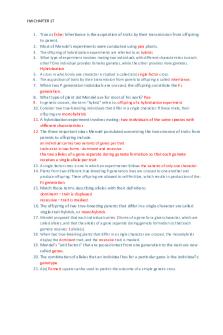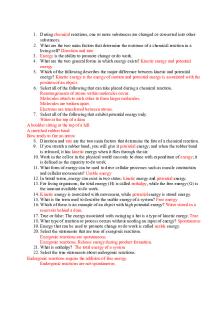Bio hw Ch 10 questions/answers with Professor Vladimir Poltoratsky PDF

| Title | Bio hw Ch 10 questions/answers with Professor Vladimir Poltoratsky |
|---|---|
| Course | Fund Of Bio Ii |
| Institution | St. John's University |
| Pages | 5 |
| File Size | 81.7 KB |
| File Type | |
| Total Downloads | 51 |
| Total Views | 157 |
Summary
Bio hw Ch 10 questions/answers with Professor Vladimir Poltoratsky...
Description
1. Which of the following best describes an organism that is composed of two or more cells? Multicellular 2. Animal cells secrete a(n)
, which provides organization and
support, whereas plant cells possess , which provide a similar function. 3. Which of the following types of organisms have cells that are surrounded by a cell wall that provides structure and support? Plants Fungi Bacteria Archaea 4. Which of the following types of molecules are chiefly responsible for connecting components of the extracellular matrix (ECM) to cells, organizing the ECM, and providing it with tensile strength and elasticity? Proteins 5. Which of the following proteins are adhesive proteins of the extracellular matrix that bind components of the ECM to each other and/or to cell surfaces? Fibronectin Laminin 6. A multicellular organism is: composed of more than one cell 7. How do adhesive proteins work? They have sites that bind to polysaccharides and proteins in the extracellular matrix. They are able to connect to receptors on the surfaces of cells. 8. How do plants and animals differ in regard to support and organization of cells? Plant cells are surrounded by cell walls, whereas animal cells secrete an extracellular matrix for support and organization. 9. True or false: Collagen and elastin are structural proteins that both provide elasticity to the body parts in which they are found. False 10. Animal cells differ from bacteria, fungus, and plant cells because: they do not have cell walls for support and organization they secrete an extracellular matrix for support and organization 11. The functions of the various proteins in the extracellular matrix are: to organize the extracellular matrix to provide tensile strength to provide elasticity to connect cells to components of the extracellular matrix 12. What is the function of structural proteins found in the extracellular matrix (ECM)? impart tensile strength and elasticity 13. Which of the following are structural proteins in the extracellular matrix? Collagen
Elastin 14. Adhesive proteins, such as fibronectin and laminin, possess multiple binding sites to other proteins as well as to cell surface receptors. Thus, they are able to adhere ECM components together and to the cell surface. 15. A key function of collagen is to impart tensile strength to certain parts of an animal's body. 16. Although they are both structural proteins, collagen provides tensile strength, whereas elastin provides elasticity to the body parts in which they are found. 17. Which of the following is the main function of collagen? To provide tensile strength to the extracellular matrix. 18. In animals, the protein collagen is a major component of various body parts, such as bone, cartilage, tendons, and skin, as well as the lining of blood vessels and internal organs. 19. In mammals, collagen is the most prevalent protein, making up what percentage of the total protein mass? 25% 20. What is the precursor to collagen? Procollagen 21. The structure of a typical collagen protein is: a triple helix of polypeptides 22. The ability of the lungs to expand and contract is due to fibers made of: elastin 23. Collagen is the main protein found in which of the following body parts? Skin Bones Tendons The lining of internal organs Cartilage The lining of blood vessels 24. In the bodies of mammals, the most abundant protein is collagen. 25. The two most prevalent types of macromolecules in the extracellular matrix of animals are proteins and polysaccharides. 26. A triple helix molecule, called procollagen, becomes collagen when its extension sequences are removed by extracellular enzymes following secretion from the cell. 27. What are the functions of the plant cell wall? It prevents osmotic lysis. It provides mechanical support. It maintains cell shape. It helps to determine the direction of cell growth. 28. All types of collagen have a common structure in which three polypeptides wind around one another to form a triple helix. 29. The cell wall of plants is composed of two parts: a flexible layer called the primary cell wall that is synthesized first, and a thicker layer called the secondary cell wall that consists of successive layers.
30. What protein, found in the extracellular matrix of animals, forms fibers and is abundant in regions that expand and contract, such as the lungs and blood vessels? elastin 31. In plants and animals, cells are linked to one another by: cell junction 32. Proteins are a major component of the extracellular matrix in animals. The second major molecular component are polysaccharides. 33. In plants, the cell wall provides mechanical support, maintains cell shape, and prevents osmotic lysis. 34. What component of a plant cell wall is synthesized first? primary cell wall 35. Cell junctions that hold adjacent cells together or attach cells to the extracellular matrix are known as anchoring junctions. 36. Cell junctions are specialized structures within a higher organism that link cells together. 37. Anchoring junctions that create cell-to-cell junctions contain proteins called cadherins. 38. Which of the following structures prevent material from passing in between adjacent cells of animals. Tight junctions 39. In animals, gap junctions form channels between cells that allow cells to communicate with one another. 40. In plants, the middle lamella cements adjacent cell walls together. 41. Anchoring junctions are cell junctions that hold adjacent cells together or attach cells to the extracellular matrix. 42. What type of cell junctions form channels between adjacent plant cells? plasmodesmata 43. What is the function of cadherins? They create cell-to-cell junctions. 44. A group of cells with a similar structure and function is called a(n) tissue. 45. In animals, cell junctions called tight junctions form a seal between adjacent cells to prevent leakage of material. 46. An organ is made of two or more: tissue 47. What do gap junctions do in animals? Provide passageways for intercellular transport 48. Animals contain four general types of tissue that are specialized for different functions. Match each tissue type with its function. Epithelial tissue – Forms the lining of internal and external surfaces Connective tissue – Provides support for the body and joins different tissues to each other Nervous tissue – Receives, generates, and conducts electrical signals throughout the body Muscle tissue – Generates force to move the body or to move materials through the body 49. What is the function of the middle lamella in plants? Holds adjacent cell walls together 50. Which of the following are general types of tissue found in the body of an animal? 51. Which of the following are general types of tissue found in the body of an animal? Epithelial Nervous Muscle Connective
52. The intercellular channels that connect plant cells to one another are called plasmodesmata. 53. In animals, connective tissue is largely composed of extracellular matrix and contains relatively few cells. 54. A tissue is a group of cells having a similar structure and function. 55. Epithelial tissue is composed of cells that are joined together by: tight junctions 56. A collection of two or more tissues that perform a specific function is called a(n) organ. 57. In plants, complex tissues defined as tissues that are composed of two or more cell types. 58. Match each animal tissue with the correct description. Epithelial tissue - Tissue made of continuous sheets of cells joined by tight junctions Connective tissue - Tissue that is rich in extracellular matrix correct Nervous tissue - Tissue that can receive, generate, and conduct electrical signals Muscle tissue - Tissue that can generate force 59. The three general types of tissue found in plants are dermal, ground, and vascular tissues. 60. The four general types of tissue found in animals are epithelial tissue, connective tissue, nervous tissue, and muscle tissue. 61. The epithelial tissue in animals is most closely comparable in function to the dermal tissue of plants. 62. Connective tissue is characterized by: a large amount of extracellular matrix 63. What type of tissue forms coverings on various parts of plants? Dermal tissue 64. Which of the following is the best description of epithelial tissue? Continuous sheets of cells joined by tight junctions 65. Match each type of plant tissue with its function. Dermal tissue - the surfaces of leaves, stems, and roots Ground tissue - Carries out photosynthesis, stores carbohydrates, and provides structural Vascular tissue - Transports water and nutrients 66. Which of the following statements best describes a simple tissue in plants? Composed of one or two cell types 67. The epidermis refers to the newly made tissue on the surfaces of leaves, stems, and roots. 68. In animals, connective tissue provides structural support. In plants, ground tissue has this role. 69. Both plants and animals have tissues that cover the surface of the organism. In plants, this tissue is called dermal tissue, and in animals, this tissue is called epithelial tissue. 70. In plants, ground tissue has a variety of functions, including photosynthesis and structural support. 71. The dermal tissue is a complex tissue that forms a covering on various parts of the plant. 72. What are the three types of ground tissue in plants? Sclerenchyma Collenchyma Parenchyma
73. Plants have three general tissue types. vascular tissue transports water and nutrients, dermal tissue covers the surface of the plant, and ground tissue stores carbohydrates and provides structural support for the plant. 74. The two types of vascular tissue are called xylem and phloem. 75. The ground tissue in plants is most closely comparable in function to the connective tissue of animals. 76. The three types of ground tissue are sclerenchyma, collenchyma, and parenchyma....
Similar Free PDFs

Bio E 10 HW 1 - HW 1 Answers
- 5 Pages

Ch. 10 HW Solutions - Edward Lynch
- 29 Pages

HW Ch 1 - HW Ch 1
- 3 Pages

BIO 210 Macromolecules HW
- 6 Pages

Bio hw 7 photosynthesis
- 4 Pages

Ch 5 hw - ch 5
- 10 Pages

Pdf-10 - HW 10 SOL
- 4 Pages

CH 6 HW: Listening
- 2 Pages
Popular Institutions
- Tinajero National High School - Annex
- Politeknik Caltex Riau
- Yokohama City University
- SGT University
- University of Al-Qadisiyah
- Divine Word College of Vigan
- Techniek College Rotterdam
- Universidade de Santiago
- Universiti Teknologi MARA Cawangan Johor Kampus Pasir Gudang
- Poltekkes Kemenkes Yogyakarta
- Baguio City National High School
- Colegio san marcos
- preparatoria uno
- Centro de Bachillerato Tecnológico Industrial y de Servicios No. 107
- Dalian Maritime University
- Quang Trung Secondary School
- Colegio Tecnológico en Informática
- Corporación Regional de Educación Superior
- Grupo CEDVA
- Dar Al Uloom University
- Centro de Estudios Preuniversitarios de la Universidad Nacional de Ingeniería
- 上智大学
- Aakash International School, Nuna Majara
- San Felipe Neri Catholic School
- Kang Chiao International School - New Taipei City
- Misamis Occidental National High School
- Institución Educativa Escuela Normal Juan Ladrilleros
- Kolehiyo ng Pantukan
- Batanes State College
- Instituto Continental
- Sekolah Menengah Kejuruan Kesehatan Kaltara (Tarakan)
- Colegio de La Inmaculada Concepcion - Cebu







